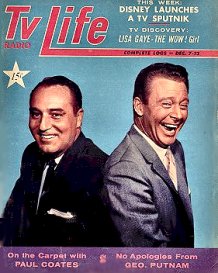
Paul Coates, left, is pictured with fellow KTTV news personality George Putnam on the cover of the Dec. 7-13, 1957 issue of TV-Radio Life, a local television magazine.
Thursday, January 16, 2003
Page 14
REMINISCING (Column)
Paul Coates: Journalist
By ROGER M. GRACE
KTTV, Channel 11, owed its status as L.A.’s top-rated independent station during the 1950s largely to its on-air personalities.
Its two key nighttime personalities, whom I mentioned last week, were George Putnam and Paul Coates. Both boasting a large following, they were opposites. Putnam was KTTV’s loud and flamboyant news anchor, a skilled showman. Coates, sedate and stone-faced, was the station’s crack journalist.
|
|
Paul Coates, left, is pictured with fellow KTTV news personality George Putnam on the cover of the Dec. 7-13, 1957 issue of TV-Radio Life, a local television magazine. |
Putnam’s voice is still booming on the airwaves. He broadcasts over an Orange County radio station. Coates died in Los Angeles on Nov. 16, 1968 at the age of 47.
Today, I’ll talk about Coates.
Coates was a columnist for the Los Angeles Mirror (and, when that paper folded in 1962, for the Times). Times-Mirror’s TV station, KTTV, presented his weekly “Confidential File,” comprised of a 15-minute filmed documentary on this controversial topic or that, followed by a 15-minute live interview related to the topic. The show began in 1953 and ended in 1958.
In the Dec. 11, 1953 issue of TV-Radio Life, Coates (who previously worked at Channel 2) said of his new show:
“I want to expose rackets in Los Angeles. All kinds of rackets. I’ll have B-Girls, and prostitutes, religious quacks, and unscrupulous businessmen on my program. I’ll show the public who and what these people are.
“I’ll take people where they ordinarily couldn’t and wouldn’t go. It’ll be ‘Off-Beat Journalism’ on TV. It won’t be nice, but I believe it will be effective and will make for a better city and better community.”
That was Coates’ goal. And he met it.
The Sunday, Jan. 9, 1955 TV Guide description of the show was: “Paul Coates reveals strange facts. ARB rates this show 6th in Los Angeles.”
Here’s TV Guide’s program listing (which reads more like an ad) for a show slated for Monday, Sept. 9, 1957: “Some call modern artists’ work a disguised form of obscenity. Some say it is brazenly subversive!! What do you think? Paul Coates takes drastic measures to find out the truth about this controversial medium on tonight’s show.”
On one installment, dealing with compulsive gambling, two high-stakes betters appeared wearing hoods, to conceal their identities, while they discussed their obsession. His shows probed such topics as homosexuality, the effects of LSD, and executions.
From 1955-57, there was a weekly, nationally syndicated version of the show.
Coates hosted other shows on KTTV, including “Flashback,” which went on the air Feb. 10, 1954. TV Guide announced in its Feb. 5, 1954 issue: “Paul Coates will show old newsreels and interview guests who had a part in the events.” An ad on March 2, 1955 in the L.A. Times read: “Paul Coates presents FLASHBACK!—to 1920, the year of the Harding-Cox elections, revolt in Turkey and lavish Mary Pickford-Doug Fairbanks wedding.”
In 1956, “Paul Coates’ Unit One” was aired on Wednesday nights, presenting remotes.
The following year, KTTV launched Coates’ 15-minute late-night interview show—“Paul Coates’ Ten-Fifteen File”—which followed a 15-minute news report by Putnam. In the early 1960s, Coates became part of KTTV’s late night triumvirate: Putnam delivering the news and commercial spiels at 10, Coates with an interview at 10:30, and Tom Duggan with interviews, commentary and a parade of live commercials at 11. By 1963, the one-hour news show was in vogue (based on Channel 2’s success in expanding its “Big News” to that duration) and Coates’ interviews became a segment of the 60-minute “George Putnam and the News.”
An article in the Dec. 7, 1957 issue of TV-Radio Life aptly described Coates as “KTTV’s urbane master of the art of probing.” He was a crusader, a communicator, a truth-seeker. Coates explored what had been taboo subjects on television, doing so without sensationalism, but with frankness. His interviews were incisive. He was focused, serious-minded, and effective.
And on rare occasion, he would smile.
Copyright 2003, Metropolitan News Company